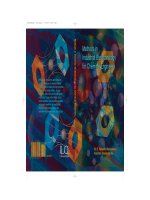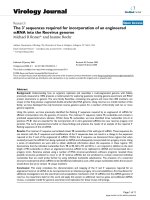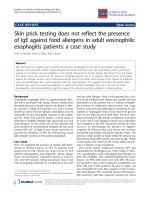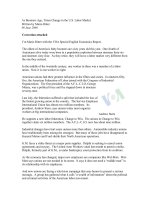The case against perfection ethics in the age of genetic engineering
Bạn đang xem bản rút gọn của tài liệu. Xem và tải ngay bản đầy đủ của tài liệu tại đây (523.32 KB, 177 trang )
The Case against Perfection
The Case against
Perfection
ETHICS
IN
GENETIC
THE
AGE
OF
ENGINEERING
Michael J. Sandel
THE
BELKNAP
HARVARD
PRESS
UNIVERSITY
OF
PRESS
Cambridge, Massachusetts, and London, England
2007
Copyright © 2007 by Michael J. Sandel
All rights reserved
Printed in the United States of America
Library of Congress Cataloging-in-Publication Data
Sandel, Michael J.
The case against perfection : ethics in the age of genetic
engineering / Michael J. Sandel.
p. cm.
Includes bibliographical references and index.
ISBN-13: 978-0-674-01927-0 (alk. paper)
ISBN-10: 0-674-01927-X (alk. paper)
1. Genetic engineering—Moral and ethical aspects. I. Title.
QH438.7.S2634 2007
174′.957—dc22
2006039327
For Adam and Aaron
Acknowledgments
My interest in ethics and biotechnology was
prompted by an unexpected invitation, in late
2001, to serve on the newly formed President’s
Council on Bioethics. Although I am not a professional bioethicist, I was intrigued by the prospect of
thinking my way through controversies over stem
cell research, cloning, and genetic engineering in
the company of a distinguished group of scientists,
philosophers, theologians, physicians, legal scholars, and public policy experts. I found the discussions enormously stimulating and intellectually intense, so much so that I decided to pursue some of
the topics in my teaching and writing. Leon Kass,
who chaired the council during the four years I
served, was largely responsible for the high level of
the discussions. Although he and I have strong
philosophical and political differences, I admire
Leon’s unerring eye for important questions and
vii
acknowledgments
am grateful to him for having embroiled the council, and me, in far-reaching bioethical inquiries the
likes of which few governmental bodies undertake.
One of the questions that most intrigued me
concerned the ethics of genetic enhancement. I
wrote a short discussion paper on the subject for
the council, and, with the encouragement of Cullen Murphy, developed it into an essay for the Atlantic Monthly in 2004. Cullen is a writer’s dream
editor—a smart, sympathetic critic with a keen
moral sensibility and exquisite editorial judgment.
I am indebted to Cullen for suggesting the title of
this book, and for nurturing the essay of the same
title that first appeared in the pages of his magazine. I am also grateful to Corby Kummer, who
helped edit the essay from which this book was
born.
For the past several years I have had the privilege
of exploring the themes of this book with Harvard
undergraduates, graduate students, and law students in seminars I have taught on ethics and biotechnology. In 2006 I teamed up with my colleague and friend Douglas Melton to teach a new
undergraduate course, Ethics, Biotechnology, and
the Future of Human Nature. More than a distinguished biologist and stem cell pioneer, Doug has
viii
acknowledgments
the philosopher’s knack for asking seemingly innocent questions that go to the heart of the matter. It
has been a great pleasure to explore these questions
in his company.
I am grateful for having had the opportunity to
try out various of the arguments presented in this
book in the Moffett Lecture at Princeton University; the Geller Lecture at NYU School of Medicine; the Dasan Memorial Lecture in Seoul, South
Korea; a public lecture at an international conference in Berlin organized by the Deutsches Referenzzentrum für Ethik in den Biowissenschaften
(DRZE); a public lecture at the Collège de
France, Paris; and a bioethics colloquium cosponsored by the National Institutes of Health, Johns
Hopkins University, and Georgetown University. I
learned a great deal from the comments and criticisms offered by participants in those occasions. I
am also grateful for the support of the Harvard Law
School summer research program, and the Carnegie Scholars program of the Carnegie Corporation,
which graciously allowed me this intellectual detour along the way to a future (and not wholly unrelated) project on the moral limits of markets.
I would like also to record my thanks to Michael
Aronson, my editor at Harvard University Press,
ix
acknowledgments
who has guided this book to completion with exemplary patience and care, and to Julie Hagen for
her fine copy editing. Finally, I am indebted above
all to my wife, Kiku Adatto, whose intellectual and
spiritual sensibilities improved this book and me. I
dedicate the book to our sons, Adam and Aaron,
who are perfect just as they are.
x
Contents
1. The Ethics of Enhancement
1
2. Bionic Athletes
25
3. Designer Children, Designing Parents
45
4. The Old Eugenics and the New
63
5. Mastery and Gift
85
Epilogue.
Embryo Ethics: The Stem Cell Debate
101
Notes
Index
131
156
The Case against Perfection
1
The Ethics of Enhancement
A f e w y e a r s a g o , a couple decided they
wanted to have a child, preferably a deaf one. Both
partners were deaf, and proudly so. Like others in
the deaf-pride community, Sharon Duchesneau
and Candy McCullough considered deafness a
cultural identity, not a disability to be cured. “Being deaf is just a way of life,” said Duchesneau.
“We feel whole as deaf people and we want to
share the wonderful aspects of our deaf community—a sense of belonging and connectedness—
with children. We truly feel we live rich lives as
deaf people.”1
In hopes of conceiving a deaf child, they sought
out a sperm donor with five generations of deafness in his family. And they succeeded. Their son
Gauvin was born deaf.
The new parents were surprised when their
story, which was reported in the Washington Post,
1
The
Case
against
Perfection
brought widespread condemnation. Most of the
outrage focused on the charge that they had deliberately inflicted a disability on their child. Duchesneau and McCullough (who are lesbian partners) denied that deafness is a disability and argued
that they had simply wanted a child like themselves. “We do not view what we did as very different from what many straight couples do when they
have children,” said Duchesneau.2
Is it wrong to make a child deaf by design? If so,
what makes it wrong—the deafness or the design?
Suppose, for the sake of argument, that deafness is
not a disability but a distinctive identity. Is there
still something wrong with the idea of parents picking and choosing the kind of child they will have?
Or do parents do that all the time, in their choice
of mate and, these days, in their use of new reproductive technologies?
Not long before the controversy over the deaf
child, an ad appeared in the Harvard Crimson and
other Ivy League student newspapers. An infertile
couple was seeking an egg donor, but not just any
egg donor. She had to be five feet, ten inches tall,
athletic, without major family medical problems,
and to have a combined SAT score of 1400 or
above. In exchange for an egg from a donor meet2
The Ethics of Enhancement
ing this description, the ad offered payment of
$50,000.3
Perhaps the parents who offered the hefty sum
for a premium egg simply wanted a child who resembled them. Or perhaps they were hoping to
trade up, trying for a child who would be taller
or smarter than they. Whatever the case, their extraordinary offer did not prompt the public outcry that met the parents who wanted a deaf child.
No one objected that height, intelligence, and
athletic prowess are disabilities that children
should be spared. And yet something about the ad
leaves a lingering moral qualm. Even if no harm is
involved, isn’t there something troubling about
parents ordering up a child with certain genetic
traits?
Some defend the attempt to conceive a deaf
child, or one who will have high SAT scores, as
similar to natural procreation in one crucial respect: whatever these parents did to increase the
odds, they were not guaranteed the outcome they
sought. Both attempts were still subject to the vagaries of the genetic lottery. This defense raises an
intriguing question. Why does some element of
unpredictability seem to make a moral difference?
Suppose biotechnology could remove the uncer3
The
Case
against
Perfection
tainty and allow us to design the genetic traits of
our children?
While pondering this question, put aside children for a moment and consider pets. About a year
after the furor over the deliberately deaf child, a
Texas woman named Julie (she declined to give
her last name) was mourning the death of her beloved cat Nicky. “He was very beautiful,” Julie said.
“He was exceptionally intelligent. He knew eleven
commands.” She had read of a company in California that offered a cat cloning service—Genetic
Savings & Clone. In 2001 the company had succeeded in creating the first cloned cat (named CC,
for Carbon Copy). Julie sent the company a genetic sample of Nicky, along with the required fee
of $50,000. A few months later, to her great delight,
she received Little Nicky, a genetically identical
cat. “He is identical,” Julie proclaimed. “I have not
been able to see one difference.”4
The company’s Web site has since announced a
price reduction for cat cloning, which now costs
a mere $32,000. If the price still seems steep, it
comes with a money-back guarantee: “If you feel
that your kitten doesn’t sufficiently resemble the
genetic donor, we’ll refund your money in full with
no questions asked.” Meanwhile, the company’s
4
The Ethics of Enhancement
scientists are working to develop a new product
line—cloned dogs. Since dogs are harder to clone
than cats, the company plans to charge $100,000
or more.5
Many people find something odd about the
commercial cloning of cats and dogs. Some complain that, with thousands of strays in need of good
homes, it is unconscionable to spend a small fortune to create a custom-made pet. Others worry
about the number of animals lost during pregnancy in the attempt to create a successful clone.
But suppose these problems could be overcome.
Would the cloning of cats and dogs still give us
pause? What about the cloning of human beings?
Articulating Our Unease
Breakthroughs in genetics present us with a promise and a predicament. The promise is that we may
soon be able to treat and prevent a host of debilitating diseases. The predicament is that our newfound genetic knowledge may also enable us to
manipulate our own nature—to enhance our muscles, memories, and moods; to choose the sex,
height, and other genetic traits of our children; to
improve our physical and cognitive capacities; to
5
The
Case
against
Perfection
make ourselves “better than well.”6 Most people
find at least some forms of genetic engineering disquieting. But it is not easy to articulate the source
of our unease. The familiar terms of moral and
political discourse make it difficult to say what is
wrong with reengineering our nature.
Consider again the question of cloning. The
birth of Dolly the cloned sheep in 1997 brought a
torrent of worry about the prospect of cloned human beings. There are good medical reasons to
worry. Most scientists agree that cloning is unsafe
and likely to produce offspring with serious abnormalities and birth defects. (Dolly died a premature
death.) But suppose cloning technology improves
to the point where the risks are no greater than with
natural pregnancy. Would human cloning still be
objectionable? What exactly is wrong with creating
a child who is a genetic twin of his or her parent, or
of an older sibling who has tragically died, or, for
that matter, of an admired scientist, sports star, or
celebrity?
Some say cloning is wrong because it violates the
child’s right to autonomy. By choosing in advance
the genetic makeup of the child, the parents consign her to a life in the shadow of someone who
6
The Ethics of Enhancement
has gone before, and so deprive the child of her
right to an open future. The autonomy objection
can be raised not only against cloning but also
against any form of bioengineering that allows parents to choose their child’s genetic characteristics.
According to this objection, the problem with genetic engineering is that “designer children” are
not fully free; even favorable genetic enhancements (for musical talent, say, or athletic prowess)
would point children toward particular life choices,
impairing their autonomy and violating their right
to choose their life plan for themselves.
At first glance, the autonomy argument seems
to capture what is troubling about human cloning
and other forms of genetic engineering. But it is
not persuasive, for two reasons. First, it wrongly implies that, absent a designing parent, children are
free to choose their physical characteristics for
themselves. But none of us chooses our own genetic inheritance. The alternative to a cloned or
genetically enhanced child is not one whose future
is unbiased and unbound by particular talents, but
a child at the mercy of the genetic lottery.
Second, even if a concern for autonomy explains
some of our worries about made-to-order children,
7
The
Case
against
Perfection
it cannot explain our moral hesitation about people who seek genetic enhancements for themselves. Not all genetic interventions are passed down
the generations. Gene therapy on nonreproductive
(or somatic) cells, such as muscle cells or brain
cells, works by repairing or replacing defective
genes. The moral quandary arises when people use
such therapy not to cure a disease but to reach beyond health, to enhance their physical or cognitive
capacities, to lift themselves above the norm.
This moral quandary has nothing to do with
impairing autonomy. Only germline genetic interventions, which target eggs, sperm, or embryos, affect subsequent generations. An athlete who genetically enhances his muscles does not confer on his
progeny his added speed and strength; he cannot
be charged with foisting talents on his children
that may push them toward an athletic career. And
yet there is still something unsettling about the
prospect of genetically altered athletes.
Like cosmetic surgery, genetic enhancement
employs medical means for nonmedical ends—
ends unrelated to curing or preventing disease, repairing injury, or restoring health. But unlike cosmetic surgery, genetic enhancement is not merely
8
The Ethics of Enhancement
cosmetic. It is more than skin deep. Even somatic
enhancements, which would not reach our children and grandchildren, raise hard moral questions. If we are ambivalent about plastic surgery
and Botox injections for sagging chins and furrowed brows, we are all the more troubled by genetic engineering for stronger bodies, sharper memories, greater intelligence, and happier moods. The
question is whether we are right to be troubled—
and if so, on what grounds?
When science moves faster than moral understanding, as it does today, men and women struggle
to articulate their unease. In liberal societies, they
reach first for the language of autonomy, fairness,
and individual rights. But this part of our moral vocabulary does not equip us to address the hardest
questions posed by cloning, designer children, and
genetic engineering. That is why the genomic revolution has induced a kind of moral vertigo. To
grapple with the ethics of enhancement, we need
to confront questions largely lost from view in the
modern world—questions about the moral status
of nature, and about the proper stance of human
beings toward the given world. Since these questions verge on theology, modern philosophers and
9
The
Case
against
Perfection
political theorists tend to shrink from them. But
our new powers of biotechnology make them unavoidable.
Genetic Engineering
To see how this is so, consider four examples of bioengineering already on the horizon: muscle enhancement, memory enhancement, height enhancement, and sex selection. In each case, what
began as an attempt to treat a disease or prevent a
genetic disorder now beckons as an instrument of
improvement and consumer choice.
Muscles
Everyone would welcome a gene therapy to alleviate muscular dystrophy and to reverse the debilitating muscle loss that comes with old age. But what
if the same therapy were used to produce genetically altered athletes? Researchers have developed
a synthetic gene that, when injected into the muscle cells of mice, makes muscles grow and prevents
them from deteriorating with age. The success
bodes well for human applications. Dr. H. Lee
Sweeney, who leads the research, hopes his discovery will cure the immobility that afflicts the elderly.
10









